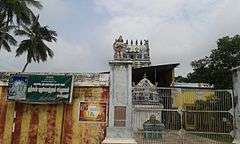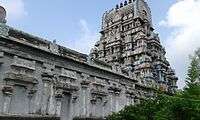Thiruvanpurushothamam
| Purushotama Perumal Temple | |
|---|---|
 | |
 Purushotama Perumal Temple Location in Tamil Nadu | |
| Name | |
| Proper name | Thiru Vanpurushothamam |
| Geography | |
| Coordinates | 11°10′39″N 79°46′45″E / 11.17750°N 79.77917°ECoordinates: 11°10′39″N 79°46′45″E / 11.17750°N 79.77917°E |
| Country | India |
| State | Tamil Nadu |
| District | Nagapatnam |
| Location | Thirunangur |
| Culture | |
| Primary deity | Purushotama Perumal(Vishnu) |
| Consort | Pusushottama Nayaki(Lakshmi) |
| Poets | Thirumangai Alvar |
| Architecture | |
| Architectural styles | Dravidian architecture |
Purushotama Perumal Temple is located in Thirunangur, a village in the outskirts of Tiruchirappalli in the South Indian state of Tamil Nadu, is dedicated to the Hindu god Vishnu. Constructed in the Dravidian style of architecture, the temple is glorified in the Divya Prabandha, the early medieval Tamil canon of the Azhwar saints from the 6th–9th centuries AD. It is one of the 108 Divyadesam dedicated to Vishnu, who is worshipped as Purushottaman and his consort Lakshmi as Purushottama Nayagi.[1]
It is one among the eleven divyadesams of Thirunangur Tirupathis and is closely associated with Thirumangai Alvar. The temple is open from 8 a.m. to 10 a.m. and 5 p.m. to 7 p.m and has four daily rituals at various times of the day. The Thirumangai Azhwar Mangalasasana Utsavam celebrated annually during the Tamil month of Thai is the major festival of the temple during which the festival images of the eleven Thirunangur Tirupathis are brought on mount designed like Garuda, called Garuda Vahana, to Thirunangur.
Architecture
The temple has a small shrine with Vimanam and only one sanctum. It is surrounded by paddy fields and is located in Thirunangur, a small village, 10 km away from Sirkali en route to Thiruvenkadu. The temple has a three tiered vimana (shrine over the sanctum), and the temple is enclosed by rectangular walls. The image of the presiding deity Purushottaman and his consort Purushottanayagi are depicted in standing posture. The image of the festival deities are also housed in the same shrine.[2]
Literary mention
Purshottama Perumal temple is revered in Nalayira Divya Prabhandam, the 7th–9th century Vaishnava canon, by Thirumangai Azhwar. The temple is classified as a Divyadesam, one of the 108 Vishnu temples that are mentioned in the book. During the 18th and 19th centuries, the temple finds mention in several works like 108 Tirupathi Anthathi by Divya Kavi Pillai Perumal Aiyangar.[3]
Worship practices and festivals

The temple is open from 8 a.m. to 10 a.m. and 5 p.m. to 7 p.m. The temple priests perform the pooja (rituals) during festivals and on a daily basis. As at other Vishnu temples of Tamil Nadu, the priests belong to the Vaishnavaite community, a Brahmin sub-caste. The temple rituals are performed four times a day: Ushathkalam at 8 a.m., Kalasanthi at 10:00 a.m., Sayarakshai at 5:00 p.m. and Ardha Jamam at 7:00 p.m. Each ritual has three steps: alangaram (decoration), neivethanam (food offering) and deepa aradanai (waving of lamps) for both Purushottaman and Purushottama Nayagi. During the worship, religious instructions in the Vedas (sacred text) are recited by priests, and worshippers prostrate themselves in front of the temple mast. There are weekly, monthly and fortnightly rituals performed in the temple.[3]
During the new moon day of the Tamil month Thai, the festival deity of Thirumangai Azhwar is brought to the temple from Thiruvali-Thirunagari.[4] The Thirumangai Azhwar Mangalasasana Utsavam is celebrated in the Tamil month of Thai (January–February). The highlight of the festival is Garudasevai, an event in which the festival images of the eleven Thirunangur Tirupathis are brought on mount designed like Garuda, called Garuda Vahana, to Thirunangur. The festive image of Thirumangai Azhwar is also brought on a Hamsa Vahanam (palaquin) and his paasurams (verses) dedicated to each of these eleven temples are recited during the occasion. The festival images of Thirumangai Alvar and his consort Kumudavalli Naachiyar are taken in a palanquin to each of the eleven temples. The verses dedicated to each of the eleven temples are chanted in the respective shrines. This is one of the most important festivals in the region which draws thousands of visitors.[4][5]
Notes
- ↑ Hindu Pilgrimage: A Journey Through the Holy Places of Hindus All Over India. Sunita Pant Bansal.
- ↑ Anantharaman, Ambujam (2006). Temples of South India. East West Books (Madras). pp. 65–67. ISBN 978-81-88661-42-8.
- 1 2 "Sri Purushothamar temple". Dinamalar. 2014. Retrieved 31 May 2014.
- 1 2 S., Prabhu (12 July 2012). "Shrine dedicated to Arjuna". The Hindu. Retrieved 2013-09-09.
- ↑ "Garuda Sevai" (PDF). Ramanuja.org. Retrieved 2011-08-19.
References
- R., Dr. Vijayalakshmy (2001). An introduction to religion and Philosophy - Tévarám and Tivviyappirapantam (1st ed.). Chennai: International Institute of Tamil Studies.
- T., Padmaja (2002). Temples of Kr̥ṣṇa in South India: history, art, and traditions in Tamilnāḍu. New Delhi: Shakti Malik. ISBN 81-7017-398-1.